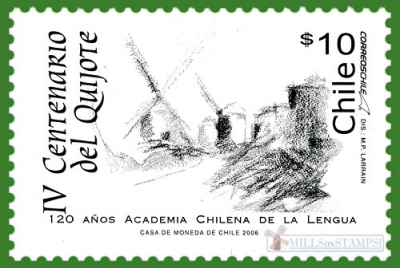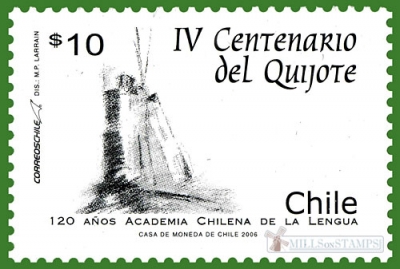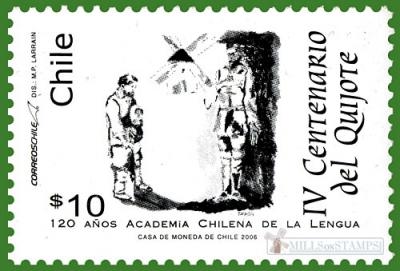-
400th Anniversary of publication of Don Quijotte. 120th Anniversary of Chilian Academy of Language. 2nd part
Chile 2006.05.31
In issue: Stamp(s): 4
Printing: offset, by strips of 4 stamps, as one set
-
Number by catalogue: Yvert: 1712 Scott: 1462b
Perforation type: 13 ½x13 ½
Subject:
10 peso. An illustration of the book - a windmills from La Mancha
Topics: Don Quijote Mills in Art Windmills
-
Number by catalogue: Yvert: 1713 Scott: 1462c
Perforation type: 13 ½x13 ½
Subject:
10 peso. An illustration of the book - a windmill from La Mancha*
Topics: Don Quijote Mills in Art Windmills
-
Number by catalogue: Yvert: 1714 Scott: 1462d
Perforation type: 13 ½x13 ½
Subject:
10 peso. An illustration of the book - Don Quixote and Sancho Panza** on a windmill background
Additional:
*Is more detailed about La Mancha and Chilean Academy of Language you can read in annotation to the first part of release
**Sancho Panza is a fictional character in the novel Don Quixote written by Spanish author Don Miguel de Cervantes Saavedra in 1602. Sancho acts as squire to Don Quixote, and provides comments throughout the novel, known as sanchismos, that are a combination of broad humor, ironic Spanish proverbs, and earthy wit. "Panza" means 'belly,' and is alternately spelled pança.
Sancho Panza is not a servant of Alonso Quijano before his madness turns him into Don Quixote, but a peasant living in the same unnamed village. When the novel begins Sancho has been married for a long time to a woman named Teresa Cascajo and has a daughter, María Sancha (also named Marisancha, Marica, María, Sancha and Sanchica), who is said to be old enough to be married. Sancho's wife is described more or less as a feminine version of Sancho, both in looks and behaviour. When Don Quixote proposes Sancho to be his squire, neither he nor his family strongly oppose it.
Sancho is illiterate and proud of it but by influence of his new master he develops considerable knowledge about some books. During the travels with Don Quixote he keeps contact with his wife by dictating letters addressed to her.
Sancho Panza offers interpolated narrative voice throughout the tale, a literary convention invented by Cervantes. Sancho Panza is precursor to "the sidekick," and is symbolic of practicality over idealism. Sancho is the everyman, who, though not sharing his master's delusional "enchantment" until late in the novel, remains his ever-faithful companion realist, and functions as the clever sidekick.
In the novel, Don Quixote comments on the historical state and condition of Aragón and Castilla, which are vying for power in Europe. Sancho Panza represents, among other things, the quintessentially Spanish brand of skepticism of the period.
Sancho obediently follows his master, despite being sometimes puzzled by Quijote's actions. Riding a mule, he helps Quixote get out of various conflicts while looking forward to rewards of aventura that Quijote tells him of.Topics: Don Quijote Mills in Art Windmills



2006-strip-logo.jpg)


